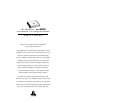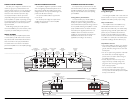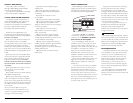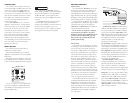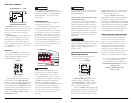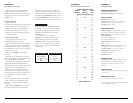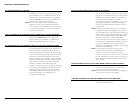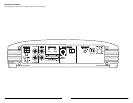
APPENDIX B:
Precise Frequency Selection Chart
“FILTER FREQ” AMP FILTER
Detent Panel Actual
Number Marking Freq.
Full counter-clockwise: 53
01 . . . . . . . . . . . . . . . . . . . . . . . .53
02 . . . . . . . . .“50” . . . . . . . . .53
03 . . . . . . . . . . . . . . . . . . . . . . . .53
04 . . . . . . . . . . . . . . . . . . . . . . . .54
05 . . . . . . . . . . . . . . . . . . . . . . . .54
06 . . . . . . . . . . . . . . . . . . . . . . . .55
07 . . . . . . . . . . . . . . . . . . . . . . . .55
08 . . . . . . . . .“55” . . . . . . . . .56
09 . . . . . . . . . . . . . . . . . . . . . . . .56
10 . . . . . . . . . . . . . . . . . . . . . . . .57
11 . . . . . . . . . . . . . . . . . . . . . . . .58
12 . . . . . . . . . . . . . . . . . . . . . . . .59
13 . . . . . . . . . . . . . . . . . . . . . . . .62
14 . . . . . . . . .“60” . . . . . . . . .65
15 . . . . . . . . . . . . . . . . . . . . . . . .65
16 . . . . . . . . . . . . . . . . . . . . . . . .66
17 . . . . . . . . . . . . . . . . . . . . . . . .70
18 . . . . . . . . . . . . . . . . . . . . . . . .73
19 . . . . . . . . . . . . . . . . . . . . . . . .77
20 . . . . . . . . .“80” . . . . . . . . .81
21 . . . . . . . . . . . . . . . . . . . . . . . .84
22 . . . . . . . . . . . . . . . . . . . . . . . .88
23 . . . . . . . . . . . . . . . . . . . . . . . .94
24 . . . . . . . . . . . . . . . . . . . . . . .101
25 . . . . . . . . . . . . . . . . . . . . . . .104
26 . . . . . . . . .“120” . . . . . . . .115
27 . . . . . . . . . . . . . . . . . . . . . . .118
28 . . . . . . . . . . . . . . . . . . . . . . .128
29 . . . . . . . . . . . . . . . . . . . . . . .137
30 . . . . . . . . . . . . . . . . . . . . . . .146
31 . . . . . . . . . . . . . . . . . . . . . . .164
32 . . . . . . . . .“150” . . . . . . . .177
33 . . . . . . . . . . . . . . . . . . . . . . .193
34 . . . . . . . . . . . . . . . . . . . . . . .197
35 . . . . . . . . . . . . . . . . . . . . . . .209
36 . . . . . . . . . . . . . . . . . . . . . . .213
37 . . . . . . . . . . . . . . . . . . . . . . .216
38 . . . . . . . . .“200” . . . . . . . .218
39 . . . . . . . . . . . . . . . . . . . . . . .225
Full-clockwise: 225
JL AUDIO e1200 11
APPENDIX C:
e1200 Specifications
GENERAL SPECIFICATIONS:
Recommended Fuse Value: 25A
Recommended Fuse Type: AGU or MaxiFuse™
INPUT SECTIONS:
No.of Inputs: One Stereo Pair
Input Type: Differential,noise-cancelling with RCA jack
inputs (low-level) and multi-pin jack (high-level)
Input Range: 200mV - 8V RMS
AMPLIFIER SECTION:
Amplifier Topology: Class AB with patented Absolute
Symmetry™ dual N-Channel MOSFET output design
Power Supply: Unregulated MOSFET switching type
Rated Power (Mono):
120W RMS x 1 @ 4Ω (12.5V)
200W RMS x 1 @ 2Ω (12.5V)
THD at Rated Power: <0.08% @ 4 ohms
(20 Hz - 20 kHz)
Signal to Noise Ratio:>104 dB referred to rated power
(A-weighted,20 Hz-20 kHz noise bandwidth)
Frequency Response: 10 Hz - 25 kHz (+0,-1dB)
Damping Factor:>200 @ 4Ω per ch./50 Hz,
>100 @ 2Ω per ch. /50 Hz
Slew Rate:± 22V/µs
AMPLIFIER FILTER:
Filter Type: State-variable, 12dB/octave Butterworth with
continuously variable cutoff frequency selection from
50-200 Hz. Configurable as Low-Pass or High-Pass.
Defeatable.
PREAMP OUTPUT:
Pass-through type. Output signal is identical to the signal at
the Amp Inputs.
DIMENSIONS (LxWxH):
9.8" x 9.25" x 2.36" (250mm x 235mm x 60mm)
Due to ongoing product development,all specifications are
subject to change without notice.
10 JL AUDIO e1200
APPENDIX A:
Input Sensitivity Level Setting
Following the directions below will allow the
installer to adjust the input sensitivity of the
amplifier(s) simply and easily in just a few minutes
using equipment which is commonly available in
installation bays.
Necessary Equipment
• Digital AC Voltmeter
• CD with a sine-wave test tone recorded at 0 dB
reference level in the frequency range to be
amplified for that set of channels (50 Hz for
subwoofer channels, 1 kHz for a midrange
application). Do not use attenuated test tones
(-10 dB, -20 dB,etc.).
The Nine-Step Procedure
1) Disconnect the speaker(s) from the
amplifier’s speaker output connectors.
2)Turn off all processing (bass/treble,loudness,
EQ, etc.) on the source unit, processors (if used)
and amplifier. Set fader control to center position
and subwoofer level control to 3/4 of maximum (if
used to feed the e1200).
3)Turn the “Input Sens.” control all the
way down.
4) Set the source unit volume to 3/4 of full
volume. This will allow for reasonable gain overlap
with moderate clipping at full volume.
5) Using the chart on this page, determine the
target voltage for input sensitivity adjustment
according to the nominal impedance of the speaker
system connected to the amplifier outputs.
6)Verify that you have disconnected the
speakers before proceeding. Play a track with an
appropriate sine wave (within the frequency range
to be amplified by the e1200) at 3/4 source
unit volume.
7) Connect the AC voltmeter to the speaker
output connectors of the amplifier using either
possitive (+) connection and either negative (-)
connection.
8) Increase the “Input Sens.” control until the
target voltage is observed with the voltmeter.
9) Once you have adjusted the e1200 to its
maximum low-distortion output level, lower the
system volume (on the source unit) and reconnect
the speaker(s).The “Input Sens.” controls can now
be adjusted downward if the amplifier requires
attenuation to achieve the desired system balance.
Do not increase any “Input Sens.” setting for
any amplifier in the system beyond the maximum
level established during this procedure. Doing so
will result in audible distortion and possible
speaker damage.
It will be necessary to re-adjust the
“Input Sens.” for the affected channels if any
equalizer boost is activated after setting the
“Input Sens.” with this procedure.This applies to
any EQ boost circuit, including source unit tone
controls or EQ circuits. EQ cuts will not require
re-adjustment.
IMPORTANT
!
Nom. Impedance Target AC Voltage
4Ω (or higher) 21.9 V
3Ω 21.0 V
2Ω 20.0 V



